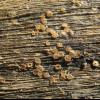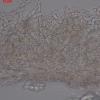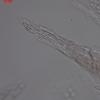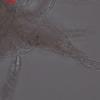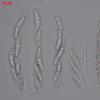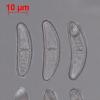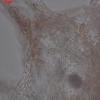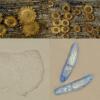
24-12-2025 17:08
Hulda Caroline HolteHello, I have found this propoloid ascomycete on

21-12-2025 09:32
Hello.A tiny ascomycete found embedded in wood in

21-12-2025 21:32
Pol DebaenstHello, Garden, Burgweg 19, Veurne, BelgiumOn 10/1

22-12-2025 23:38
Patrice TANCHAUDBonsoir, récolte sur un mur en pierre, apothéci

22-12-2025 00:47
Patrice TANCHAUDBonsoir, récolte à proximité du milieu dunaire
Bionectriaceae (Ijuhya?) from Kenya
Ibai Olariaga Ibarguren,
11-10-2013 23:53
Hi, I found in the Uppsala herbarium a collection from Kenya, with stems of Lobelia (or Euphorbiaceae ?), made by Owe Eriksson in 1968. It contains at least two apparently interesting fungi, so I thought to post it here.
The first fungus is a nectriod one, a Bionectriaceae I believe. It has densely gregarious groups of perithecia, superficial, flattened (probably because of being dry), with a little papilla, up to 0.5 mm in diam, orange-brown, unchanged in KOH, covered by hairs, except for in the apex, up to 130 µm. Perithecial wall 80 µm thick, composed by an outer region composed by 3-5 layers of subglobose hyphae, and an inner region of flattened cells, ca 10-15 µm. Asci clavate, with an apical inconscpicuos ring. Ascospores 27-32 x 7.5-9 µm, hyaline, curved, 2-celled, striate.
It reminds of the photos of Ijuhya antillana in Ascofrance. The perithecial wall structure, the presence of hairs and the spores seem to fit. I have used the Ijuhya key by Lechat & Courtecuisse (2010) and it keys out as I. chilensis, but I haven´t done more research. There are some whitish patches in the substrate that might be the anamorph, but I haven´t checked.
Any opinion? More data needed? Thanks in advance!
Cheers,
Ibai.
Christian Lechat,
12-10-2013 06:14

Re : Bionectriaceae (Ijuhya?) from Kenya
Hi Ibai,
your fungus is not the genus Ijuhya because of thickness of ascomatal wall, which is less 30 µm in this genus. Moreover, the outer region of your specimen has large and thin walled cells.
So, I think it is the genus Hydropisphaera which has cupulate ascomata when dry as on your photo.
I'm working on a monograph of the genus Hydropisphaera and it would be useful to me to see your specimen. Could you please send it to me? Thanks.
Best regards,
Christian
your fungus is not the genus Ijuhya because of thickness of ascomatal wall, which is less 30 µm in this genus. Moreover, the outer region of your specimen has large and thin walled cells.
So, I think it is the genus Hydropisphaera which has cupulate ascomata when dry as on your photo.
I'm working on a monograph of the genus Hydropisphaera and it would be useful to me to see your specimen. Could you please send it to me? Thanks.
Best regards,
Christian
Ibai Olariaga Ibarguren,
12-10-2013 16:59
Re : Bionectriaceae (Ijuhya?) from Kenya
Hi Christian,
Thank you for your quick and good answer. I am glad that you are interested in looking at the material. The material is in the Uppsala herbarium and I cannot send it freely, but I will email you privately to see what we can do.
Cheers,
Ibai.
Christian Lechat,
26-01-2014 10:51
Ibai Olariaga Ibarguren,
27-01-2014 14:19
Re : Bionectriaceae (Ijuhya?) from Kenya
Dear Chrstian,
Thanks for studying the material, very interesting! A pity that it cannot be cultivated, but at least we know now that it exists. I will keep an eye in case more material shows up in Uppsala.
Cheers,
Ibai.
